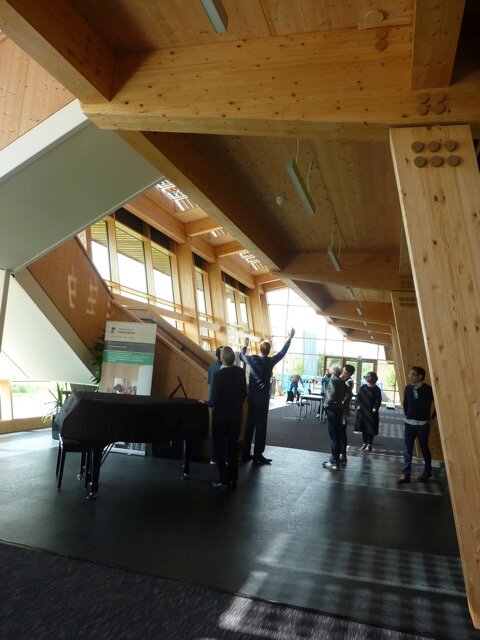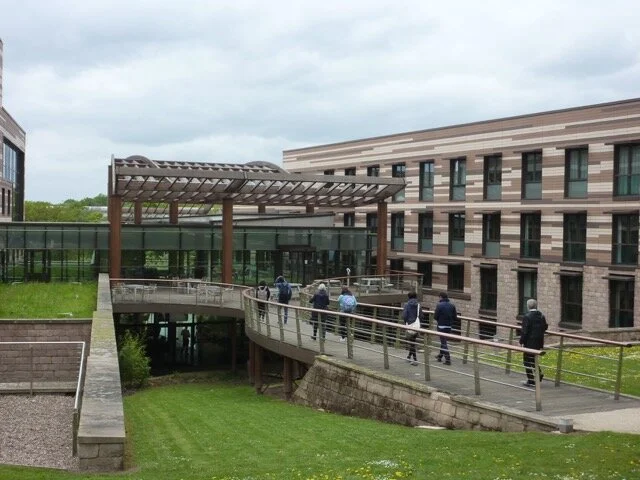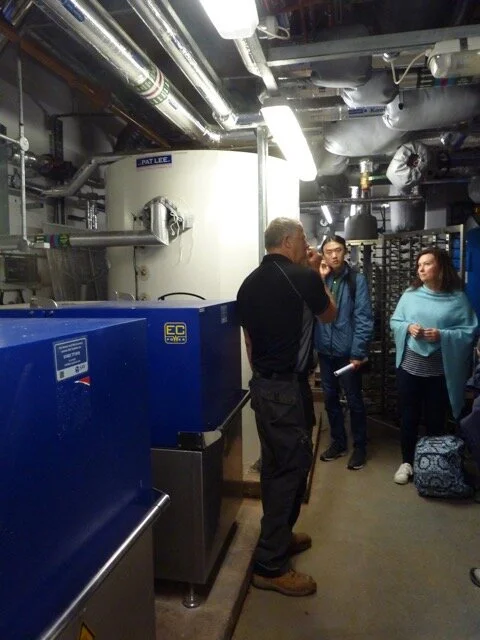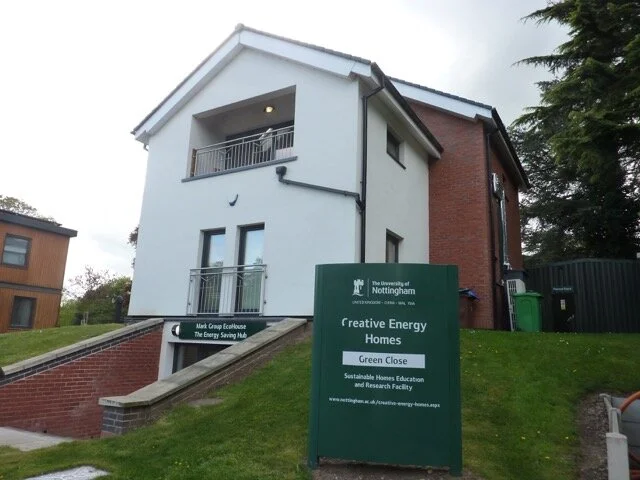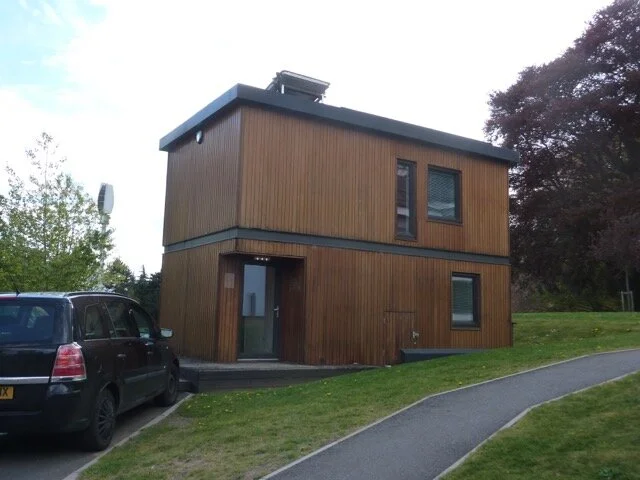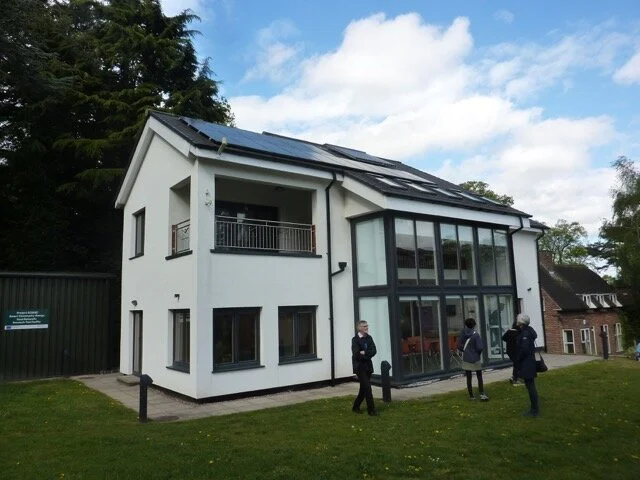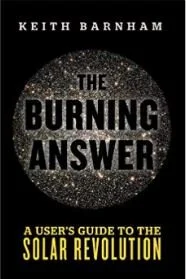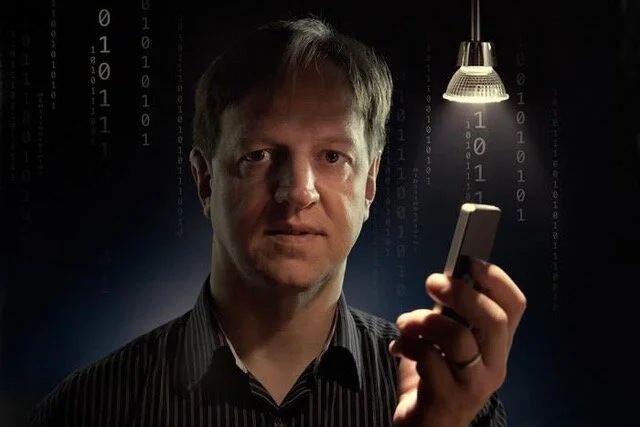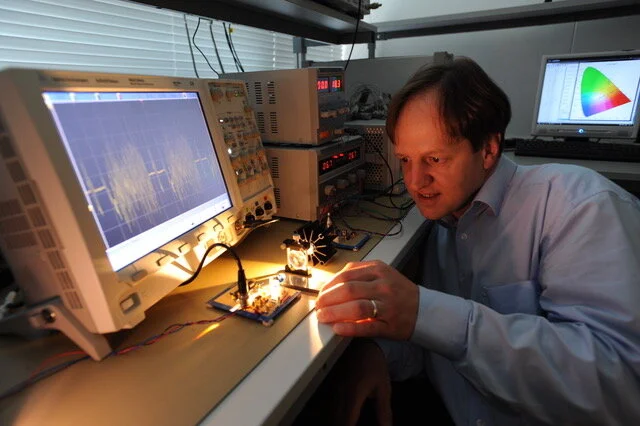Past Events
SEDA SOLAR SEMINAR SERIES #3
These are just a few selected highlights of our activities, to wet your appetite for more to come in the future.
Past events 2020
SEDA SOLAR SEMINAR SERIES #2: PHOTO-eLECTRIC ADVANCEMENT
SEDA Solar Seminar Series #1 : Solar THERMAL Revival
Past Events 2019
Easter visit to Nottingham 26-27 April 2019
GlaxoSmithKline Carbon Neutral Laboratory for Sustainable Chemistry, University of Nottingham
Delegates from SSEG at the GlaxoSmithKline Carbon Neutral Laboratory for Sustainable Chemistry
The GlaxoSmithKline Carbon Neutral Laboratory for Sustainable Chemistry is the latest landmark development to be undertaken by The University of Nottingham on its Jubilee Campus. Located on the University’s award winning innovation Park, the new carbon neutral laboratory building provides unrivalled facilities for chemistry. The focus on sustainability is reflected in the building itself, which incorporates the latest technologies to allow it to be carbon-neutral over its lifetime.
In April 2017, the building was awarded the BREEAM Outstanding and LEED Platinum certifications – the highest levels of green building certifications. Timber for the building’s frame had to be transported by boat from Europe in order to comply with LEED requirements.
More information at: https:/www.nottingham.ac.uk/chemistry/research/centre-for-sustainable-chemistry/the-carbon-neutral-laboratory.aspx
De Vere Orchard Hotel
Set in 330 acres of the University of Nottingham’s landscaped parkland, De Vere Orchard Hotel is a eco-friendly hotel with energy saving and water saving features. Awarded with Best Sustainable Venue at the CHS 2017 and 2019 Awards, at De Vere Orchard Hotel has been built to the highest environmental standards.
More information: https://www.devere.co.uk/orchard/
Creative Energy Homes
Creative Energy Homes is a £1.9m project, that is a key resource, particularly with respect to micro- smart grids, energy storage, demand-side management and occupants’ acceptance of innovative technologies. The seven-house development provides a living test-site for industry partners to work with Nottingham University to investigate the integration of energy efficient technologies into houses. The research findings have fed into the UK government’s Green Deal strategy and the Nottingham Community Climate Change Strategy.
More information: https://www.nottingham.ac.uk/creative-energy-homes/index.aspx
Public Lecture Prof Keith Barnham Date: 5 March 2019
Speaker: Prof Keith Barnham Affiliation: Emeritus Professor of Physics / Distinguished Research Fellow, Imperial College London Topic: James Clerk Maxwell: his contribution to Scotland’s all-renewable electricity target Summary:
Keith started off by pointing out that solar photovoltaic (PV) is the only form of electricity generation that does not involve any moving parts. Unlike all other forms of electricity generation, which transform mechanical energy (turning of turbines) into electricity, solar PV produces electricity instantaneously i.e. the moment sunlight (photon) hits a PV cell.
This shows the importance of James Clerk Maxwell’s discovery of solar energy as an electromagnetic wave in 1865, touted as the most significant event in 19th century by physics Noble laureate Richard Feynman.
Keith then proceeded to explain electric field and magnetic field and their respective equations (Gauss laws, now also known as Maxwell’s 1 st and 2nd equations). Then came Maxwell’s 3 rd equation, also known as Faraday’s law, saying that change in time of magnetic field through a loop generates electric field round the loop. This is the equation that explains all forms of electricity generation but one – photovoltaics. Finally, Ampere’s law, expressed as electric current in wire produces a magnetic field loop (Maxwell’s 4th equation).
However, Maxwell observed that electric current does not turn off immediately when a switch is thrown, but takes time to fall to zero. (You have probably noticed this in the LED on your flat screen TV or laptop charger). Perhaps something was missing from Ampere’s law? To account for this extra factor, Maxwell amended Ampere’s law and made it anti-symmetric with Faraday’s law, stating that change in time of electric current in wire produces a magnetic field loop (Maxwell’s new 4 th equation).
Combining this new 4 th equation and Faraday’s law, Maxwell arrived at a single wave equation. The speed of this new type of wave was a very large number, very close to a number he knew very well. It was an important number in a very different branch of physics. The new wave had speed = 3 x 10 8 m/s.
It was the speed of light! Maxwell had discovered that light is actually an electromagnetic wave. Unlike other major theoretical discoveries in physics, Maxwell didn’t need to wait for an experiment to confirm his prediction. It couldn’t be a coincidence that the speed of his electro-magnetic wave was the same as this very large number.
This resulted in huge changes in physics :
Optics, the study of light, had suddenly become the study of electromagnetic waves.
By uniting electricity and magnetism into a new force electromagnetism, Maxwell had reduced the number of fundamental forces then required to explain Nature.
Previously 3 fundamental forces in physics: gravity, electricity, magnetism
Now two fundamental forces: gravity, electromagnetism
- He had unleashed a technology that ultimately gave us most of our modern devices, from giant particle accelerators down to mobile phone devices, and hopefully ultimately to non- burning energy security.
Maxwell’s law remains unchanged since 1865 – over 154 years until today – despite numerous physics revolutions and other unifications of fundamental forces.
(Reference: The Burning Answer, Keith Barnham 2015, Weidenfeld and Nicolson)
Getting It From The Sun (GIFTS) – modeling using Excel
In the second half of the lecture, Keith explained how solar electricity could help UK and Scotland achieve 100% renewable electricity supply, specifically Scotland’s all-renewable 2020 target. As the power generation pattern of solar PV fits nicely with peak daytime demand, which happens around noon, solar PV was able to reduce the daytime peak price of German electricity by 20% when PV provided only 3% of the energy in a year. The GIFTS spreadsheet shows how PV and wind can provide around 80% of the UK power in a year and bio-electricity the 15% flexible back-up with around 5% storage. Had it not been for the Westminster government’s subsidy cuts the UK could have had an all-renewable power supply by 2025. Keith also suggested that UK should fully tap the potential of flexible bio-electricity from food and farm waste and pumped hydro for storage especially in Scotland.
As all of the case studies were based on UK data, it is important to assess the situation in Scotland alone. Through analysis of installation data, Keith argues that Scotland could achieve its all- renewable target by 2020 with huge contribution from wind energy even under a business-as-usual scenario. However, the all-renewable target is insufficient to supply for 100% of electricity demand hour-by-hour by 2020.
To achieve this, a paradigm shift especially in solar PV installation is imperative. Solar PV installation experienced exponential growth from 2010 to 2014 thanks to the introduction of Feed-in-Tariff (FiT) in 2010, but was plateauing from 2015 to 2018. With the FiT ending in 1 April 2019, solar PV installation could see a further stagnation if new policy is not in.
A detailed analysis of hourly supply and demand with the GIFTS spreadsheet was undertaken by Environmental MSc. students and showed that considerably more flexible bio-electricity is necessary. However, the amount of farm and food waste sent for Anaerobic Digestion, which then provides biomethane for the gas-grid, can be counted towards Scotland’s hour-by hour all-renewable target. Also, so can the proportion of households that have switched to an all-renewable electricity supplier. It was extremely encouraging that a show of hands indicated more than half the audience had switched.
The current practice of analysing annual total energy demand and supply does not give due recognition to solar power’s significant contribution to peak demand and the complementary effect of wind and solar power, but encourages base load generation such as nuclear energy.
Prof Keith Barnham’s book is available at: https://www.amazon.co.uk/Burning-Answer-Users-Guide- Revolution/dp/0297869639
Past Events 2018
Visit: Appleton Tower, University of Edinburgh (UoE) Date: 31 May 2018
Summary: Although the visit had a focus of the 2016 vertical PV array fitted over a nearly due south wall, this was part of a much wider face-lifting programme and general refurbishment and renovation, including complete façade renewal, the insertion of a new pent-house floor and upgrading the lighting and ventilation system. Buro Happold together with LDN Architects took on this major modernisation of the 1966 original by architects Alan Reiach, Eric Hall and Partners. Indeed all this had earned the upgrade an RICS ‘Design for Innovation’ Award in April 2018, just one month previously.
The 23kWp PV VERTICAL system comprises 72 Sunpower E20/327 panels, a strip 18 panels high by four wide (72 in all). This is integrated with the new cladding and, visually, there is no sign of ventilation behind the PV.
The other main aspect of interest to us was the new part-manual and part-automated natural ventilation system for the tower itself, the latter of particular interest since the peak demand, and hence peak electrical loads from fans and so forth (mainly elsewhere in the building) are likely to coincide with peak PV generation. Both the manually operated system of ventilation, grilled vertical panels, behind which are three opening hoppers, and the automated natural one, horizontal grilled strips with “internal actuated opening panel to control ventilation”, are evident on the new façade as well as internally, the latter in a bulkhead arrangement above fixed windows and the vertical panels of manually operated vents. We noted, partially with regard to ventilation ducting elsewhere and services in general, that thermal mass had been effectively increased via the device of grilled/slatted acoustic ceilings, thus deflecting the eye from the concrete doors above, but not their stabilising thermal advantage.
We were also told how this particular building, now part of the Universities Informatics Department, was tied in with the third of one of five CHP plants: 1) 500kW Pollock halls; 2) 2.7MW Kings Buildings; 3) 1.6MW George Square, plus 600kW absorption chillers; 4) 1.4MW Pleasance; 5) 1.4MW Easterbush. Thus thermal needs as well as those of electrical power were shared around various buildings within each area, George Square in this instance.
Many thanks to David, John and Ian for taking their time for this most interesting tour.
Past Events 2017
Visit: Harlaw Hydro
Date: March 2017
Summary: On this occasion, March 2017, committee member Rory O’Riordan organised a visit to a small community-led venture, Harlaw Hydro located in the Pentland foothills above Balerno. Quoting from the website: “Harlaw Hydro was initiated by Balerno Village Trust [BVT] and until 2012 was a BVT project. In September 2012 Harlaw Hydro Ltd, an Independent Provident Society for the Benefit of the Community, was formed and the newly constituted Harlaw Hydro set about raising the capital and managing the construction of the hydro scheme.”
Rory had arranged for us to be met by Alistair, Ian and Martin, colleagues on this project, who explained the challenges encountered between 2012, with £403,000 share capital raised by December 2014, and the opening of the completed installation in September 2015 by Fergus Ewing, MSP and Scottish Government Minister. They had liaised with the City of Edinburgh Council, and achieved planning permission at a relatively early stage having explored the feasibility of five sites. That at Harlaw offered a good head of water (up to 17m), the reservoir feeding the Bavelaw Burn that flows into the Water of Leith, and originally used to regulate flow to water mills downstream. We were informed that the surplus FIT income from its generation, after paying off the interest on loans and so forth, was paid to Balerno Village Trust (BVT) for the benefit of the community.
The engineering set-up is simple, a pipe running steeply downhill from a hollow tubular vertical ‘penstock’ or reservoir dam out flow to a new powerhouse, a relatively small utilitarian shed at a distance of some 115 metres as the crow flies and, as noted above, up to 17 metres below reservoir water level. Before reaching the powerhouse there is a flood release valve into the burn and a final short branch pipe to the turbine itself. With a power rating of 95kW, this is estimated to generate approximately 260,000kWh annually, equivalent to approximately 129 tonnes of CO 2.
All power generated goes straight to the grid, with a battery to power the electronic controls; even the lighting in the powerhouse comes from the grid, although that used for maintenance and visitors such as us must be modest. To facilitate the venture a new 200kW transformer was required close to the Harlaw House Rangers Centre (just north of the northeast corner of the reservoir), replacing the existing 25kW one.
The irony of this renewable source thriving on maximum rainfall, and hence minimum solar radiation, was not lost on us, but then life is all about balance. But rhetorical questions aside, many thanks to Rory and your team of BVT guides for facilitating this visit.
Public Lecture by Prof. Harold Haas
Date: 01 December 2017
Affiliation: Director of LiFi R&D Centre at the University of Edinburgh; Chief Scientific Officer of pureLiFi Ltd
Topic: Introduction to the current status and development of LiFi
Summary: LiFi (light fidelity) is a complete wireless network system using light (e.g. from off-the-shelf or IC-chip integrated LED) instead of radio wave. This is a ‘visual light communications’ (VLC) system, which runs wireless communications that travel at very high speeds (Note: light wave frequency: 4 - 7 x 10 14 Hz; radio wave frequency: 10 4 Hz).
Diagramme demonstrating the concept of WiFi and LiFi
Solar cells can also be turned into LiFi receivers, receiving data and generating electricity simultaneously from a LED light/data source. Such LiFi system would cope with isolated locations often still without access to the internet, say an isolated cottage with a PV array more than a kilometre away from a beamed LED source on a hilltop.
In terms of the competitive advantages of LiFi, Harald listed security, energy efficiency, localisation, data destiny and safety. Harald speaks of a ‘light-connected world’ and hopes to have 80 billion devices connected in this way by 2020, an increase of 60% per annum. Effectively it denotes ‘sustainable ICT for the future’, with data driving the next revolution.
(Source: Suntimes 37; http://www.homepages.ed.ac.uk/hxh/Li-Fi_PAPERS/What_is_LiFi_pdf.pdf)



